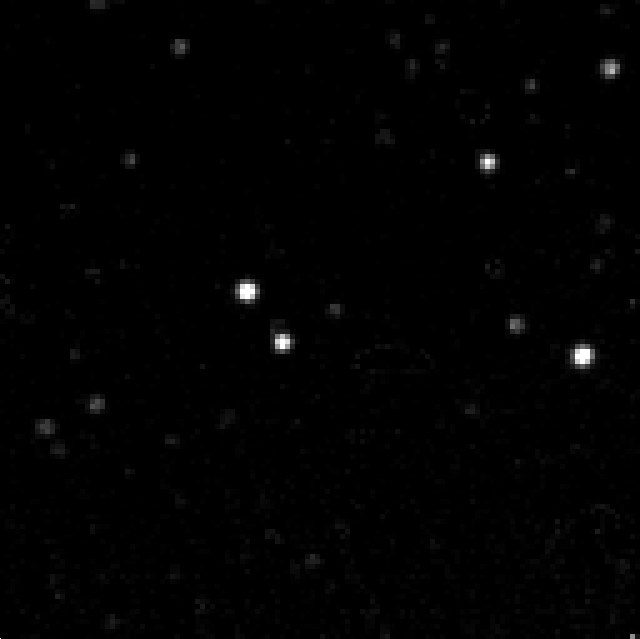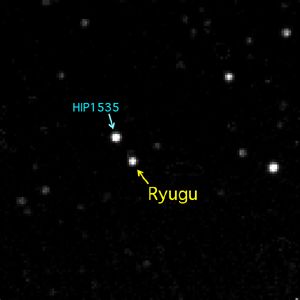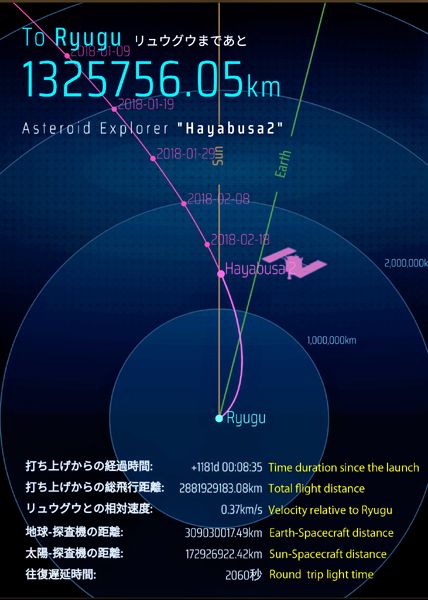

JAXA
Hayabusa 2 Has Detected Ryugu! (Press Release)
On February 26, 2018, Hayabusa 2 saw its destination—asteroid Ryugu—for the first time! The photographs were captured by the ONC-T (Optical Navigation Camera - Telescopic) onboard the spacecraft. Images were taken between noon JST on February 26th and 9:00 AM the following morning, with about 300 shots taken in total. Data for nine of these images were transmitted from the spacecraft on February 27th, allowing us to confirm that Ryugu had indeed been seen. The animation shows these nine consecutive frames.
Ryugu's brightness from Hayabusa 2 is about magnitude 9, which would be impossible to see with the naked eye but visible with the ONC-T. Looking at the image above, you can see how the position of the surrounding stars relative to Ryugu appears to change as Hayabusa 2 moves towards the asteroid. The distance between Ryugu and Hayabusa 2 when the images were taken is about 1.3 million km. Ryugu as seen from Hayabusa 2 is in the direction of the constellation Pisces.
Ryugu was photographed when the Sun, Hayabusa 2 and Ryugu were almost in a line. This configuration can be seen in the figure below, which shows a snapshot of the header from the Hayabusa 2 website on February 26, 2018, which continuously updates to show the position of Hayabusa 2. If you were to stand on Ryugu, Hayabusa 2 would be seen in the direction of the Sun.
Hayabusa 2 is currently using its ion engine to make adjustments to its course. This makes it difficult to alter the orientation of the spacecraft. However, at the alignment shown below, the ONC-T camera can image Ryugu without needing to make significant changes to the spacecraft's orientation. This made February 26th the perfect time to try and capture Ryugu's image with the ONC-T. From the data, Ryugu was observed to be exactly at the expected location based on Hayabusa 2's estimated position. This tells us that Hayabusa 2 is flying on the planned course.
"Now that we see Ryugu, the Hayabusa 2 project has shifted to the final preparation stage for arrival at the asteroid. There are no problems with the route towards Ryugu or the performance of the spacecraft, and we will be proceeding with maximum thrust," explains Project Manager, Yuichi Tsuda.
The remaining images will be transmitted back to Earth from the spacecraft and allow us to further confirm the asteroid and spacecraft location. Although we can currently see Ryugu only as a point, it is very exciting for the whole project team to catch sight of the destination! The ONC-T was developed under collaboration between JAXA, the University of Tokyo, Kochi University, Rikkyo University, Nagoya University, Chiba Institute of Technology, Meiji University, The University of Aizu, the National Institute of Advanced Industrial Science and Technology (AIST).
Source: Japan Aerospace Exploration Agency
****

JAXA

No comments:
Post a Comment